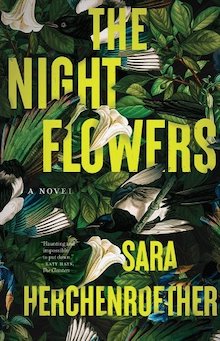
Tin House, 2023
Laura MacDonald, librarian and genealogist, is in the hospital undergoing treatment for breast cancer when she becomes absorbed in a cold case centered on the discovery, made by hikers in New Mexico’s remote Gila National Forest some thirty years before, of barrels containing the bodies of an unidentified woman and two girls. Solving this decades-old crime brings Laura into contact with Jean Martinez, a detective who is fighting for her job and with it, her sense of herself as an independent adult. Identifying the dead woman becomes their personal mission, and their journey is at the heart of The Night Flowers, Sara Herchenroether’s debut.
The novel is not a traditional “whodunit.” There is no “ticking clock” against which the murderer must be stopped before he strikes again; as fifty years have passed since the original crime, the murderer is unlikely to be both alive and dangerous. In its place is a character-driven story that moves the reader to cheer as much for the discovery of the victim’s identity as for the identification and capture of the murderer.
Each of the novel’s central characters grapples with anonymity. Herchenroether makes the parallel between Laura, menaced by a disease that turns her into a nameless statistic, and the dead woman, known only as Jane Doe, explicit from the start: “In the Gila wilderness, Jane Doe had no name, no date of birth. Here, in the hospital wilderness, Laura was only her name and date of birth. She had no voice. No identity outside her diagnosis. Both had lost control of their bodies.” The detective, Jean Martinez, faces a different anonymity crisis. She is being pressured by her husband to retire from the police force. He expects her to embrace a new stage of life as an involved grandparent, but Jean can’t imagine life without her job. Working in the cold cases division, Jean senses that retirement will entail the loss not only of her adult identity but also of the chance to learn the murder victims’ names and stories.
Both Jean and Laura are tired of being acted upon; they wish, instead, to become protagonists. In this, they share something else with Jane Doe who, after being silenced and nameless for decades, addresses herself to the reader as a restless ghost. She describes how she became the object of others’ wishes, from her parents’ decisions about where she’d be raised, to her boyfriend’s idea of where and how to live. The ghost says, “I thought life was the choices you made, and lately, it felt like all my choices were made for me.”
This ghost is an animate presence, capable of telling her story and of influencing the sensations and actions of living creatures. Of course, this is a narrative device, a way for the author to reveal aspects of Doe’s story that would not otherwise be available to the characters. But the touch of magic also feels consistent with the everyday miracles that present themselves elsewhere: surviving cancer when others do not, and bringing a murderer to justice decades after the investigative trail went cold.
The mystery of how a woman and two girls ended up dead and anonymous, interred in barrels in a forest, also haunts the text. We live in a world where identity matters, where the importance of one’s name is announced by titles in popular culture. Know My Name says Chanel Miller’s memoir. “Say My Name” sings Beyonce. Call Me By My Name cry the book and film of the same title. A victim robbed of her identity defies the sensibilities of a society that trumpets individual achievement. The reader needs Jean and Laura to succeed, not merely to restore names to the victims, but to restore order to the world.
When Jean visits the site where the barrels were found, she discovers night flowers there. These flowers open at night, but they also reveal themselves in other circumstances, as when a finger touches them. Like Jane Doe, they contain secrets that await a person’s attention to reveal themselves. Cancer, too, is a kind of night flower, hiding in plain sight until the radiologist points her scope in the right place.
In her acknowledgments, the author, herself a breast cancer survivor, cites a statistic that 1,000 John and Jane Does remain unidentified each year. According to the CDC, about 264,000 cases of breast cancer are diagnosed in the U.S. annually. If those numbers point to our inability to control our fates, perhaps we can take comfort from Jane Doe’s ghost, who turns out to have (some) agency. She might have been powerless in life and nameless in death, but in her afterlife, she narrates the past and exerts influence in the present.
Hospitalized again for reconstructive surgery, Laura develops a severe, mysterious postoperative illness. Teetering on the brink of death, Laura is finally diagnosed with an infection by an anonymous nurse. “Laura never found out her name […] Her life had been saved, not by science but by chance […] What would have happened if that nurse hadn’t walked into her room that morning?” Perhaps, then, The Night Flowers hints at the importance not of triumphing over anonymity, but of using the power we have for good, and accepting the help of others when our powers fail us.
+++
Sara Herchenroether lives outside Columbus, Ohio, with her husband, four young children, one old dog, and two rescue kittens. Sara is a breast cancer survivor.
+
Jill Witty is querying a novel about two sisters who take revenge on a sexual assailant. Her work has been published in Catapult, CRAFT Literary, The Normal School, Pithead Chapel, and elsewhere, and has been nominated for various awards including a Pushcart Prize. She resides in Richmond, Virginia with her husband, three children, and rescue dog. Find her at jillwitty.com or on Instagram @jillwittywriter.